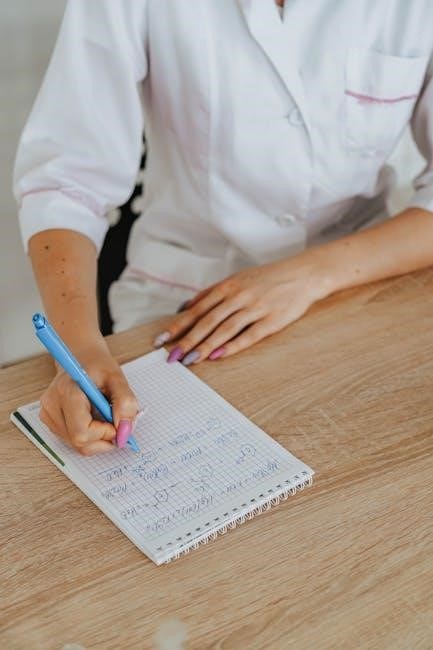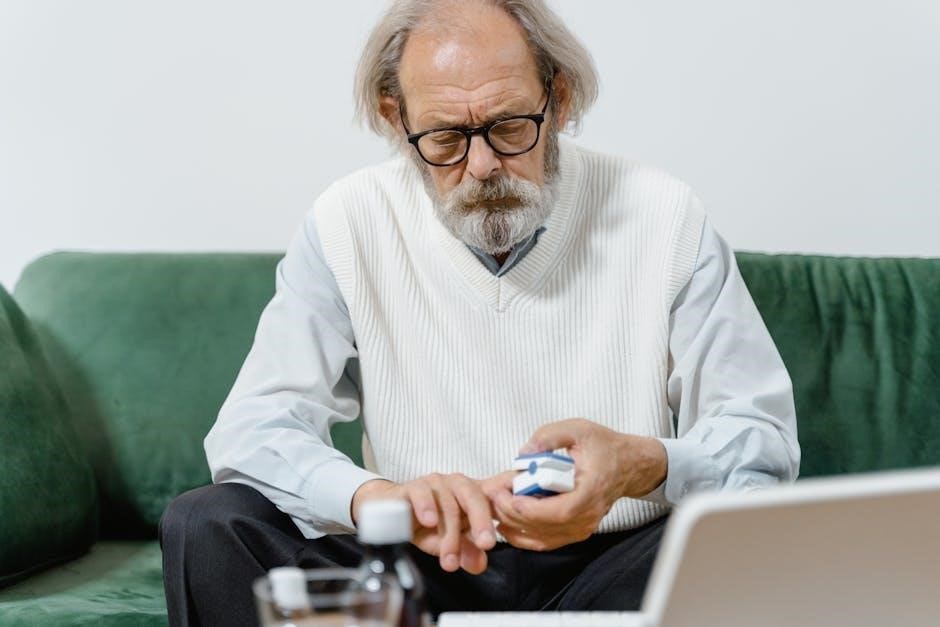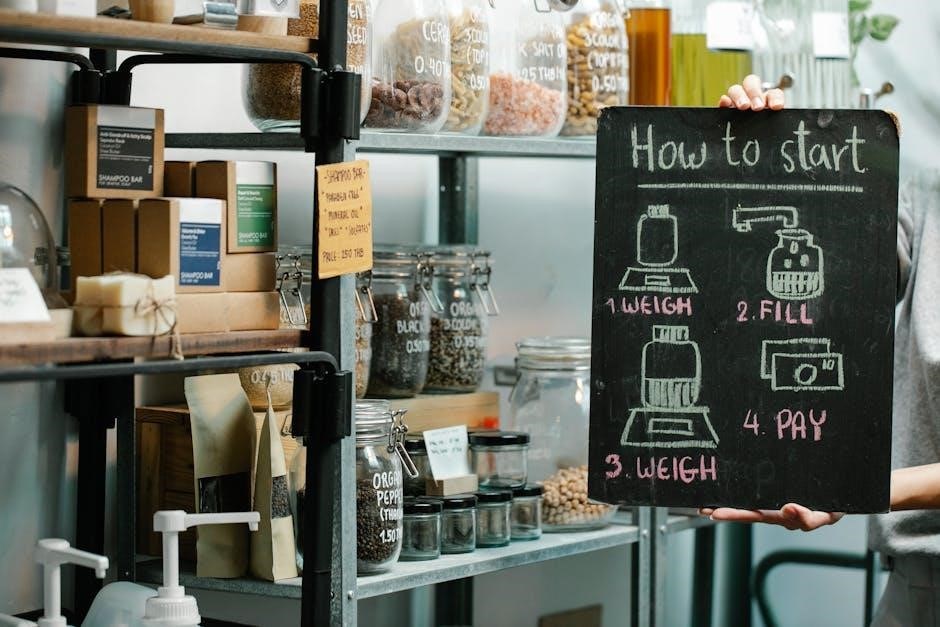Reheating food safely and effectively is crucial for maintaining quality and preventing foodborne illness. Proper techniques ensure even heating, retain nutrients, and preserve flavor.
1.1 Importance of Proper Reheating Techniques
Proper reheating techniques are essential to ensure food safety, retain nutrients, and maintain texture. Incorrect methods can lead to undercooked or overcooked food, potentially causing foodborne illnesses. Reheating evenly at the right temperature prevents harmful bacteria growth, ensuring meals remain safe and flavorful. Proper techniques also preserve the food’s texture, avoiding sogginess or dryness. By following guidelines, you can enjoy leftovers without compromising quality or health. Always reheat to the recommended internal temperature to kill bacteria and ensure a enjoyable dining experience; Proper reheating is key to safe, healthy, and delicious meal preparation.
1.2 Safety Guidelines for Reheating Food
Safe reheating involves using appliances like microwaves, ovens, or air fryers correctly. Always reheat food to an internal temperature of 165°F (74°C) to eliminate harmful bacteria. Avoid using metal containers in microwaves, as they can spark or cause uneven heating. Use microwave-safe containers and cover food to retain moisture. Stir or turn food during reheating for even distribution of heat. Never reheat food multiple times, as this can lead to bacterial growth. Ensure leftovers are stored at 40°F (4°C) or below before reheating. Follow appliance guidelines and use timers to prevent overcooking. Adhering to these guidelines ensures safe and optimal reheating results.

Food Safety and Legislation
Food safety regulations ensure public health by setting standards for food handling and reheating practices, preventing foodborne illnesses through legal frameworks and safe food preparation guidelines.
2.1 Foodborne Illnesses and Reheating
Improper reheating can lead to foodborne illnesses caused by bacteria like Salmonella, E. coli, and Staphylococcus aureus. These pathogens thrive when food isn’t heated to a safe temperature. Reheating must reach 165°F to kill harmful bacteria, as failure can result in severe health risks. Vulnerable groups, such as the elderly and young children, are more susceptible. To prevent illness, always use a food thermometer and ensure even heating. Never reheat food in “danger zones” (40°F–140°F) for extended periods, as bacteria multiply rapidly. Proper reheating techniques are essential to protect public health and maintain food safety standards, avoiding costly and dangerous foodborne diseases.
2.2 Food Safety Laws and Regulations
Food safety laws and regulations emphasize proper reheating practices to prevent foodborne illnesses. Governments worldwide enforce standards requiring food to be reheated to a minimum of 165°F to ensure safety. These laws are designed to protect public health by reducing the risk of bacterial growth and contamination. Restaurants and food establishments must adhere to strict guidelines, including proper temperature control and handling practices. Non-compliance can result in penalties and closures. Regulations also mandate proper food labeling and storage to ensure reheated meals are safe for consumption. These laws are continuously updated to reflect scientific advancements and global food safety standards.

Best Practices for Reheating
Use appliances like microwaves or air fryers for even heating. Cover food to retain moisture and ensure consistent temperatures. Stir or flip food halfway for uniform reheating. Always check internal temperatures to confirm safety and avoid overheating, which can degrade quality and texture. Avoid overcrowding containers to promote airflow and prevent undercooked spots. Reheat only what’s needed to minimize waste. Follow appliance guidelines for optimal results and food safety. Proper reheating techniques enhance flavor, texture, and safety, making leftovers enjoyable and risk-free.
3.1 Using a Microwave for Reheating
For safe and effective microwave reheating, use microwave-safe containers and avoid metal. Cover food with a lid or plastic wrap to retain moisture and promote even heating. Stir or flip food halfway through reheating to ensure uniform temperature distribution. Check internal temperatures to confirm food reaches a minimum of 165°F (74°C) for safety. Avoid overheating, as it can degrade texture and nutrients. For delicate foods like rice or vegetables, use lower power levels to prevent drying out. Always allow food to stand for a minute after reheating to ensure even heat distribution. Follow these tips for optimal results and food safety.
3.2 Reheating in an Oven or Toaster Oven
Reheating in an oven or toaster oven ensures even heating and retains food quality. Preheat the oven to the desired temperature, place food in an oven-safe dish, and cover with foil to prevent drying. For meats and vegetables, a temperature of 350°F (175°C) works well; Use a food thermometer to confirm internal temperatures reach 165°F (74°C) for safety. Let food rest for a few minutes after reheating to ensure even heat distribution. For delicate items like fish or leftovers, lower temperatures and shorter times are recommended. This method is ideal for large portions and maintaining texture and flavor.
3.3 Reheating with an Air Fryer
Reheating with an air fryer is a quick and efficient method that preserves crispiness without overcooking. Preheat the air fryer to 300-350°F (150-175°C) for 2-3 minutes. Place food in a single layer for even heating. For leftovers like fries or chicken, cook for 5-7 minutes, shaking halfway. Adjust time and temperature based on food type. Stirring ensures uniform reheating. The air fryer’s rapid air circulation restores texture and flavor, making it ideal for small batches. Always ensure food reaches 165°F (74°C) internally to maintain safety. This method is perfect for achieving restaurant-quality results at home with minimal effort.
3.4 Stirring and Turning Food During Reheating
Stirring and turning food during reheating ensures even heat distribution, preventing hotspots and undercooked areas. This technique is especially important for foods like rice, vegetables, and sauces. Use a utensil to gently stir or flip food halfway through reheating. For items like roasted vegetables or meats, turning ensures crispiness and prevents burning. In appliances like air fryers or ovens, shaking or stirring midway enhances texture and consistency. Regular stirring also helps retain moisture and flavor, avoiding dryness. Always use heat-resistant utensils and avoid over-stirring to maintain food integrity. This simple step significantly improves the quality and safety of reheated meals.

Appliance-Specific Reheating Guides
Different appliances like microwaves, ovens, air fryers, and slow cookers require tailored approaches for optimal reheating. Understanding each appliance’s capabilities ensures safe and efficient food warming.
4.1 Microwave Reheating Tips
Reheating food in the microwave is convenient but requires careful handling to ensure safety and quality. Always use microwave-safe containers and avoid metal utensils, as they can spark. Cover food with a microwave-safe lid or plastic wrap to retain moisture and promote even heating. Stir food halfway through reheating and check the internal temperature to ensure it reaches 165°F (74°C) for safety. For delicate foods like fish or vegetables, use a lower power level to prevent overcooking. Allow food to stand for 30 seconds before serving to distribute heat evenly. Never reheat eggs or rice multiple times, as this can pose health risks.
4.2 Toaster Oven Reheating Best Practices
Toaster ovens are excellent for reheating food evenly and maintaining its texture. Preheat the oven to the desired temperature before adding food. Use oven-safe dishes and avoid overcrowding to ensure proper air circulation. Covering food with foil can help retain moisture, especially for roasted vegetables or casseroles. For delicate items like fish, use a lower temperature to prevent drying out; Stir or flip food halfway through reheating for consistent results. Let food rest for a minute after reheating to allow heat to distribute evenly. This method is ideal for small batches and ensures food reheats safely and efficiently without losing flavor.
4.3 Air Fryer Reheating Techniques
Reheating food in an air fryer is quick, efficient, and preserves crispiness. Preheat the air fryer for 2-3 minutes before adding food. Place leftovers in a single layer for even heating. Use medium to low temperatures to avoid overcooking, especially for delicate foods like seafood or vegetables. Stir or shake the basket halfway through reheating to ensure uniform heating. Check food for doneness by temperature or visual inspection. For crispy results, increase the temperature slightly toward the end. The air fryer’s rapid air circulation ensures food reheats safely and retains its original texture and flavor better than microwaves;
4.4 Slow Cooker Reheating Methods
Slow cookers are ideal for reheating food evenly and gently. Place leftovers in the cooker, add a small amount of liquid if needed, and set to low or warm. Covering helps retain moisture and flavor. Stir occasionally for uniform heating. Ideal for dishes like stews or roasts. Avoid overheating, as it can dry out food. Check internal temperature to ensure safety. Perfect for keeping food warm over extended periods without compromising quality. This method is especially useful for large quantities or when precise temperature control is needed. It ensures food stays tender and flavorful, making it a great option for meal prep or leftovers.
Food-Specific Reheating Instructions
Different foods require tailored reheating methods to ensure safety and quality. Techniques vary for rice, chicken, seafood, vegetables, and leafy greens to maintain texture and flavor.
5.1 Reheating Rice Safely
Reheating rice requires attention to safety to avoid foodborne illness. Rice can harbor bacteria like Bacillus cereus, which produces toxins. To reheat safely, use a microwave or oven to reach 165°F (74°C). Add a splash of water to prevent dryness. Stir halfway through reheating to ensure even heating. Avoid leaving cooked rice at room temperature for too long, as bacteria thrive between 40°F and 140°F (4°C and 60°C). Always check for unusual odors or textures before consumption. Proper reheating ensures rice remains safe and palatable.
5.2 Reheating Chicken and Seafood
Reheating chicken and seafood requires careful attention to temperature and texture. Chicken should be reheated to an internal temperature of 165°F (74°C) to ensure food safety. Use a microwave, oven, or air fryer for even heating. For seafood, such as fish or shrimp, reheat gently to avoid overcooking, which can make it tough. Add a splash of liquid like broth or water to maintain moisture. Stir or flip halfway through reheating to distribute heat evenly. Avoid reheating seafood multiple times, as it can lead to a rubbery texture. Always check for any signs of spoilage before reheating.
5.3 Reheating Vegetables and Leafy Greens
Reheating vegetables and leafy greens can be done effectively while preserving their texture and nutrients. Steam reheating is ideal for maintaining crispiness. Microwave on high for 1-2 minutes with a splash of water. For leafy greens like spinach, sauté in a pan with olive oil to restore vibrancy. Avoid overcooking to prevent mushiness. When reheating roasted vegetables, use an oven at 350°F (175°C) for 5-10 minutes. Air fryers also work well, adding a crispy texture. Always reheat to an internal temperature of 165°F (74°C) for food safety. Season lightly after reheating to enhance flavor without overpowering the dish.

Health Risks and Texture Changes
Improper reheating can lead to foodborne illnesses and alter textures. Overheating destroys nutrients, while underheating risks bacterial growth. Use gentle methods to preserve quality and safety.
6.1 Health Concerns with Reheating Certain Foods
Reheating certain foods can pose health risks, especially if not done properly. Rice, seafood, and eggs are prone to bacterial growth if reheated inadequately. Leafy greens like spinach lose nutrients when reheated, while vegetables may become mushy. Overheating proteins like chicken or eggs can make them tough and rubbery. Proper reheating ensures food reaches a safe temperature to kill bacteria, preventing foodborne illness. Always reheat to steaming hot to maintain safety and quality. Improper techniques can lead to uneven heating, risking undercooked areas where bacteria thrive. This underscores the importance of using appropriate methods to preserve both health and texture.
6.2 Maintaining Food Texture During Reheating
Maintaining food texture during reheating requires careful techniques. Air fryers are ideal for preserving crispiness in foods like fries or chicken wings. Microwaves can soften textures if overused, so short intervals and a splash of liquid help retain moisture. Ovens are best for foods like roasted vegetables, ensuring even heating without sogginess. Stirring or turning food during reheating prevents uneven cooking and texture loss. Covering dishes in the microwave or oven retains steam, keeping food tender. For grains like rice, fluffing with a fork after reheating restores texture. Proper appliance use and gentle reheating methods help maintain the original texture of food.

Best Practices for Freezer Meals
Freezer meals require proper labeling and storage to ensure safety and quality. Reheat to steaming hot, use airtight containers, and avoid refreezing to maintain texture and flavor.
7.1 Reheating Freezer Meals Safely
Safely reheating freezer meals involves ensuring they reach an internal temperature of 165°F to eliminate harmful bacteria. Use a food thermometer for accuracy. When reheating, avoid overcrowding the appliance to allow even heating. Covering meals can help retain moisture and promote uniform heating. For frozen meals, it’s best to thaw them first in the refrigerator or microwave before reheating. Never refreeze thawed meals, as this can lead to foodborne illness. Always reheat to steaming hot to ensure food safety and quality. This method preserves nutrients and maintains the meal’s texture and flavor effectively.
7.2 Tips for Reheating Frozen Leftovers
Reheating frozen leftovers requires careful planning to ensure safety and quality. Always label leftovers with dates to maintain rotation. Thaw frozen leftovers overnight in the refrigerator or use the defrost function on your microwave. Avoid reheating directly from frozen unless specified. Use airtight containers to prevent moisture loss and contamination. When reheating, ensure the internal temperature reaches 165°F. Stir or flip food halfway through reheating for even distribution of heat. Avoid overcrowding the appliance, as this can lead to uneven cooking. For best results, add a splash of liquid to retain moisture and flavor during reheating. This ensures leftovers taste fresh and remain safe to eat.